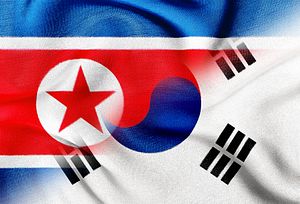Military representatives from both South Korea and North Korea met in the truce village of Panmunjom on Wednesday for the highest level military talks between the two sides in seven years. The meeting has been unofficially confirmed by several sources, but the South Korean government has not acknowledged them as of yet. According to a parliamentary source cited by South Korea’s Yonhap News, “The North does not want to make it public.” The talks come shortly after a high-level North Korean delegation comprising Hwang Pyong-so, Choe Ryong-hae, and Kim Yang-gon visited Incheon, South Korea on an impromptu trip at the close of the Asian Games. It is not known which side initiated the meeting.
While we know that military talks took place, the details of exactly who represented either side or what the agenda was remains shrouded in mystery. One anonymous official told Yonhap that the agenda focused on “how to relieve inter-Korean military tensions that have been heightened recently” — a fairly narrow objective. Given the recent trip by Hwang and co. at a time when North Korean leader Kim Jong-un hadn’t been seen for weeks (he has since reappeared), there is considerable speculation that there could be something significant in the works in inter-Korean diplomacy. Despite positive diplomatic signals, some parts of the relationship remain unchanged. For example, last week, North Korean and South Korean vessels exchanged fire across the Northern Limit Line (NLL) — the de facto maritime boundary separating the two countries. Additionally, after South Korean activists launched balloons containing leaflets across the border, the North retaliated with anti-aircraft and machine gun fire.
Earlier this year, a similar high-level meeting took place between the two Koreas — also at Panmunjon. Back then, the main issue from the North Korean perspective was the annual U.S.-South Korea Foal Eagle military exercise. North Korea was adamant in demanding the two cease the exercise. Additionally, North and South Korean officials met to decide the fate of a long-awaited inter-Korean family reunion that eventually ended up taking place. Reuters reported then that the South Korean side was represented by the president’s deputy national security adviser and the North sent the Korean’s Workers’ Party’s second-highest ranking official charged with relations with the South. Given that rapport, it could be that the same officials are involved in this Panmunjon meeting.
Regardless of the result of this meeting at Panmunjon, both Koreas agreed to hold another round of high-level talks in early November.

































